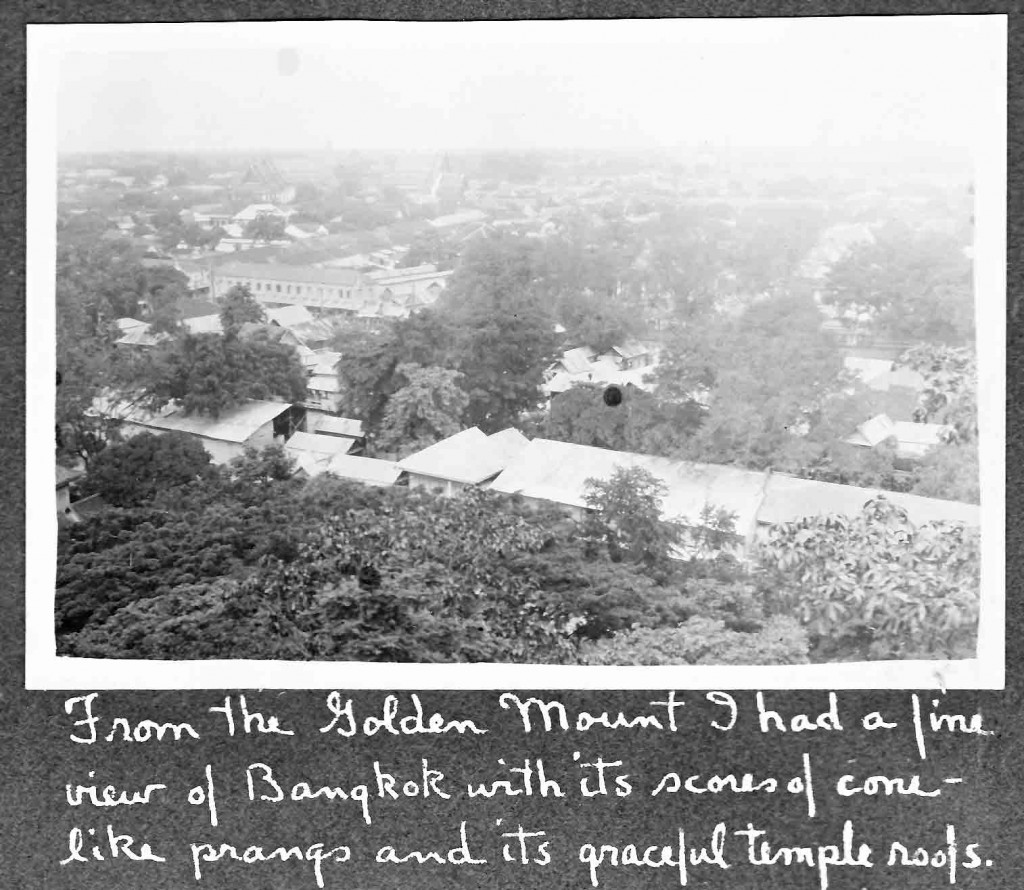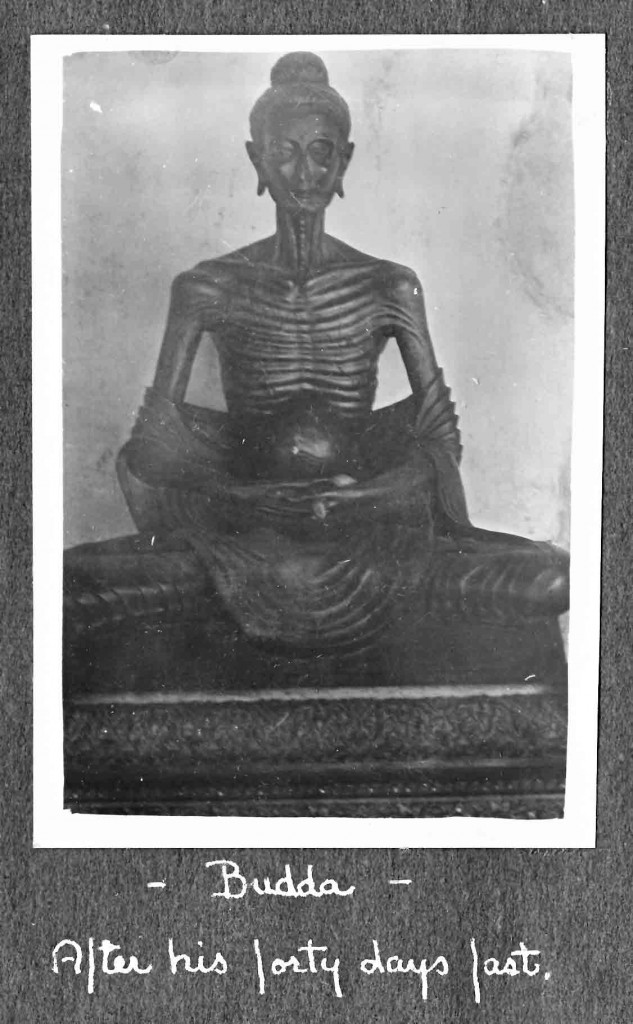Tuesday, July 23, 1929
By eight this morning I was on my way to do things. Got ritzy and rode first class in a street car and it cost me 4 cents or satang more than third. When we had reached the temple I first wished to visit, it began to pour down rain in true circus-day style. I took shelter in a doorway between two carved, painted images of Siamese soldiers and waited.
I much prefer visiting a Buddhist temple than Hindu or Mohammedan ones. You are never asked for baksheesh or any donations—the attendants are very pleasant and courteous but do not bother you by trying to point out all things of interest that you couldn’t miss if you tried, and in a foreign tongue. You are free to go and come as you wish, inspect the images, paintings, take pictures if you care to—you can walk anywhere in the temple—and with your shoes on.
The Wat Rajabojoit lies on the east side of the Saranrom Garden and consists of a tall Phra Chedi enclosed by a circular gallery with four vihara. In a vaulted room below the Chedi is a large Buddha sitting on the Naga—or a Phra Nak Brok in Siamese. Other large gilded images stand in niches around the walls. The building is all of a much ornamented tile, of many glazed colors, pictures, and designs. To the south are the buildings where the monks live—the cloisters, and also the building which is the present residence of the Prince Patriarch of the Kingdom. The whole temple is surrounded by a high whitewashed brick wall.
At the north end of Saronrom Garden is a particularly beautiful temple, though small—the Wat Rajapradisth, or the temple of Royal Creation.
Round the marble-covered walls of the Bôt is a marble colonnade. The interior walls are painted with scenes from the life of Bangkok during the early reigns of the present dynasty. The chedi prang is also marble-covered. It is not so large. On each side of the Bôt stands a Cambodian tower, or marble, according to the style of prangs of old Angkor Thom. They are both richly carved. To the east is the monastery.
 The rain had ceased, so I walked down Sanam Jai Road. Toward the river was the high white wall of the palace with its tower gates and, from within, many artistic towers, spires, prangs, chedi, and curved roofs protruding into view. Opposite stood the Saronrom Palace, well worn and now occupied by the Ministry of Foreign Affairs. Next door the large War Dept. building with a collection of old guns in the front yard. Nearly opposite and north of the Palace is the large Royal Plaza. At one corner, near the War Building, stands a small square brick building with a tall chedi—partly hidden by tamarind trees. The Lak Muang shelters a carved wood pillar—”The Phra Lak Muang” or “the pillar of the city”. The protecting angel is supposed to live here. Every village in Siam, in Central and Eastern Asia, has its Lak Muang where the local genius or spirit who owns the land upon which the city is built, resides. Crocodile skulls are supposed to gladden the spirit—accordingly there are a number placed around the outside. The Lak Muang also plays the part of oracle. Around the much-decorated pole are votive offers representing human beings. A proof of its popularity is seen at the entrance, where a huge box is full to overflowing with these offerings—all sorts of small wood and paper images of lions, gods, people, groups of people, etc.—a regular toy shop.
The rain had ceased, so I walked down Sanam Jai Road. Toward the river was the high white wall of the palace with its tower gates and, from within, many artistic towers, spires, prangs, chedi, and curved roofs protruding into view. Opposite stood the Saronrom Palace, well worn and now occupied by the Ministry of Foreign Affairs. Next door the large War Dept. building with a collection of old guns in the front yard. Nearly opposite and north of the Palace is the large Royal Plaza. At one corner, near the War Building, stands a small square brick building with a tall chedi—partly hidden by tamarind trees. The Lak Muang shelters a carved wood pillar—”The Phra Lak Muang” or “the pillar of the city”. The protecting angel is supposed to live here. Every village in Siam, in Central and Eastern Asia, has its Lak Muang where the local genius or spirit who owns the land upon which the city is built, resides. Crocodile skulls are supposed to gladden the spirit—accordingly there are a number placed around the outside. The Lak Muang also plays the part of oracle. Around the much-decorated pole are votive offers representing human beings. A proof of its popularity is seen at the entrance, where a huge box is full to overflowing with these offerings—all sorts of small wood and paper images of lions, gods, people, groups of people, etc.—a regular toy shop.
On the farther side of the Royal Plaza is the National Library where the finest collection of Cambodian Pali and Siamese Manuscripts in the world is found. As the real old ones were destroyed when invaders destroyed Ayudhya, the old capital, those here are of a more recent date. There are palm leaf books with fine inlaid cases, etc.
Directly in the rear is the Wat Mahathad or the Temple of the great relic shrine. This is the oldest of the temples on the east bank of the Menau—it was there long before Bangkok was made the capital of Siam.
The first thing you come to are the galleries in the corridors in which repose 112 gilt effigies of Buddha. Next comes the tall square mondhob in which, under a glass-inlaid and covered canopy is a partly gilt phra chedi said to contain a precious relic.
Nearby are the Bôt and vihara. In the former reposes a huge Buddha surrounded by his eight disciples. It is an impressive sight—this glittering god peering forth from the semi-gloom with his half closed eyes. Gables on these edifices are richly ornate with colored figures and designs.
It was here, in 1788, that the great religious council, after long and painstaking work, purified and re-established what is now the standard edition of the Siamese tripitaka.
This was just about enough for one morning, so I got the car back to the hotel—3rd class. Took my shoes to be fixed after lunch. Had to buy a pair of wooden affairs to get back to the hotel in. The Chinks and Siamese coolies wear them. I can’t make them stay on though and am marooned here till tomorrow morning. OK with me for it has rained all afternoon. After murdering the first two lines of Rachmaninoff’s Prelude in F# (or whatever it is) for a half hour, I gave the people a chance and quit.
Had some corn tonight that would put chiropodists out of business. They serve you a million courses here. Start out with soup,—for supper,—fish and spuds, 3rd a stew, 4th a vegetable or macaroni, etc., 5th chicken, potatoes (pommes de terre frites) and tomato salad, 6th bread and cheeses, 7th dessert, 8th fruits, and lastly coffee. Usually not very hungry after that.
